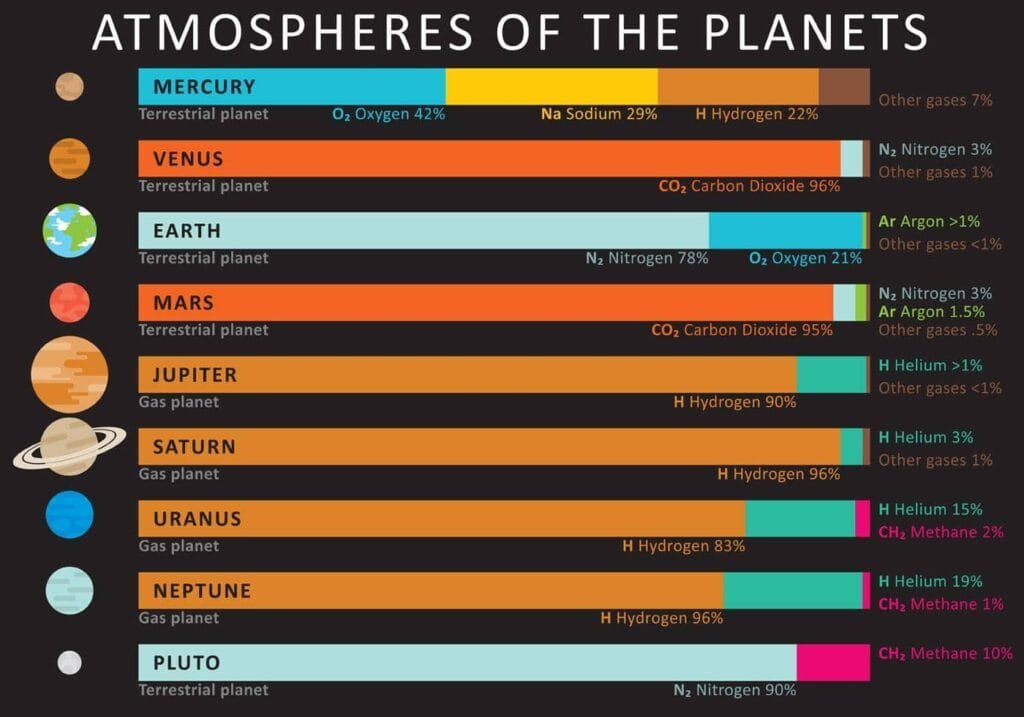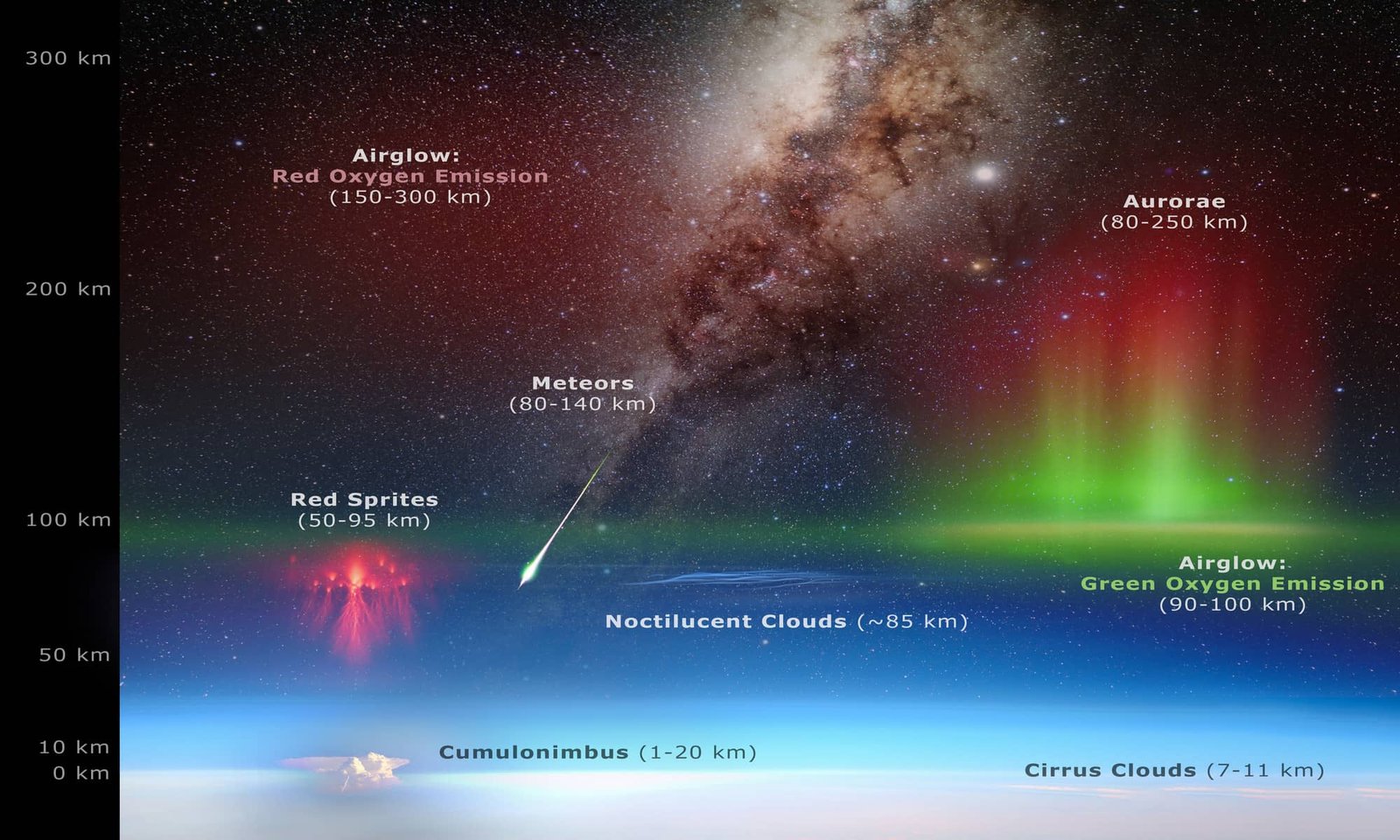The atmosphere’s unique composition is paramount for various biological and chemical processes necessary for life; for instance, oxygen is vital for respiration, while carbon dioxide is essential for photosynthesis. Beyond its composition, the atmosphere serves multiple functions that are crucial for the stability of environmental conditions on Earth. It acts as a moderating presence, regulating temperature through the greenhouse effect, which ensures that our planet maintains suitable conditions for living organisms. Furthermore, this gaseous envelope enables the dispersal of heat from the sun, thereby influencing weather patterns and climatic conditions across different regions, fostering biodiversity.
Another critical function of the atmosphere is its role as a protective shield against harmful solar radiation. The ozone layer, situated in the stratosphere, absorbs the sun’s most dangerous ultraviolet (UV) rays, preventing them from reaching the Earth’s surface and causing potential harm to living organisms. Moreover, the atmosphere protects Earth from meteoroids by causing them to burn upon entry, primarily in the mesosphere, thus minimizing potential impacts. As we move higher into the atmospheric layers, including the troposphere, stratosphere, mesosphere, thermosphere, and exosphere, the conditions and compositions continue to evolve. Understanding these varying layers and their respective functions is imperative for comprehending how they collectively support life on Earth and maintain the planet’s ecological balance.
Composition of the Atmosphere

The atmosphere surrounding our planet is a complex mixture of gases essential for life on Earth. Comprised predominantly of nitrogen and oxygen, these components play crucial roles in maintaining environmental stability. Nitrogen constitutes approximately 78% of the atmosphere, acting as a passive participant in biological processes. While nitrogen does not directly contribute to respiration, it plays a vital role in the nitrogen cycle, an essential process for the growth of plants and, consequently, all life forms.
Oxygen, making up about 21% of the atmosphere, is indispensable for most living organisms that rely on aerobic respiration.
During this process, oxygen is utilized to convert food into energy, releasing carbon dioxide as a byproduct. Carbon Dioxide, although only about 0.04% of the atmospheric composition, is significant in regulating the Earth’s temperature through the greenhouse effect. This effect is crucial for maintaining a climate conducive to life; without it, temperatures would plummet, making Earth a far less habitable place.
Additionally, trace gases such as argon, water vapour, and other greenhouse gases make up a small fraction of the atmosphere but are vital for various atmospheric functions. Argon, for instance, represents about 0.93% of the air we breathe, serving primarily as an inert filler and having minimal biological impact. Water Vapour fluctuates in concentration from 0% to about 4% depending on local conditions, playing a critical role in weather patterns and heat retention.
Structure of the Atmosphere
The structure of the atmosphere can be divided into five main layers, each with unique characteristics. These layers include the troposphere, stratosphere, mesosphere, thermosphere, and exosphere. The troposphere is where we experience weather, and as we ascend, the air becomes thinner and temperature variations occur. Each layer of the atmosphere contributes significantly to the Earth’s ecosystem. The stratosphere contains the ozone layer, which protects us from harmful ultraviolet radiation. Meanwhile, the mesosphere is where most meteors burn up upon entering the atmosphere, protecting our planet from potential impacts. In the thermosphere, the phenomenon of auroras occurs, creating beautiful displays in the sky.
Read More
- The Troposphere is the lowest layer, extending from the surface up to about 8 to 15 kilometers. This layer contains approximately 80% of the atmosphere’s mass and is primarily where weather phenomena occur. The majority of the air comprises nitrogen and oxygen, with smaller amounts of carbon dioxide, water vapor, and argon. The temperature decreases with altitude in this layer, varying from around 15°C at sea level to approximately -50°C at its boundary with the stratosphere.
- Above the troposphere lies the Stratosphere, which spans from 15 to about 50 kilometers. This layer is crucial for various atmospheric processes, including the absorption of ultraviolet radiation by the ozone layer. Here, temperatures begin to rise with altitude, reaching around 0°C at the stratopause. The steady air currents in the stratosphere play a significant role in the dispersion of pollutants and other airborne particles.
- The Mesosphere extends from 50 to about 85 kilometers. In this layer, temperatures again decrease with altitude, dipping to around -90°C. This region is significant for the disintegration of meteoroids, which burn up upon entering Earth’s atmosphere. The unique composition of the mesosphere, primarily nitrogen and oxygen, allows for these brilliant phenomena.
- Above the mesosphere, the Thermosphere stretches from 85 kilometers to around 600 kilometers. During the day, temperatures can rise significantly due to solar radiation, sometimes exceeding 1,500°C; however, the sparse air, with largely ionized particles, provides minimal heat transfer. This layer, which plays a crucial role in space travel, hosts the auroras and serves as the boundary between Earth’s atmosphere and outer space.
- Finally, the Exosphere, the outermost layer, extends from approximately 600 kilometers to 10,000 kilometers. Composed mainly of light gases like hydrogen and helium, the air is exceedingly thin. This layer represents the transition to the vacuum of space, where particles can escape into the cosmos. Understanding these layers provides insight into atmospheric dynamics, climate change, and the potential for space exploration.
The Role of the Atmosphere
Comprising layers of gases, the atmosphere not only protects Earth from harmful solar radiation but also regulates temperature and weather patterns. Understanding the role of the atmosphere is crucial for recognizing how it supports life and maintains the ecological balance. One of the atmosphere’s primary roles is to guard against the sun’s ultraviolet rays. The ozone layer, located in the stratosphere, absorbs a significant portion of these rays, thereby preventing skin cancer and other health issues. Furthermore, the atmosphere serves as a barrier against meteoroids, incinerating them before they have a chance to impact the Earth’s surface.
Weather And Climate
The atmosphere’s gases play crucial roles in determining weather patterns and climate systems. The distribution and behavior of these gases influence temperature variations, air pressure, and humidity levels, all of which are critical factors in the formation of diverse weather phenomena.
Air pressure, for instance, is the weight of the air above a given area and is a significant determinant of local weather conditions. High-pressure systems are usually associated with calm and clear weather, while low-pressure systems often lead to stormy conditions. The interaction between these pressure systems can create winds and storms, as air moves from areas of high pressure to regions of low pressure in an attempt to equalize the differences. This movement of air also affects temperature, as different layers of the atmosphere, such as the troposphere and stratosphere, have varying densities and thermal properties.
Humidity, defined as the amount of water vapor present in the air, adds another layer of complexity to weather and climate. High humidity levels can lead to condensation, resulting in clouds and precipitation. Conversely, low humidity often contributes to drier conditions. The presence of water vapor also affects the atmosphere’s capacity to retain heat, influencing local and global temperatures. Understanding humidity’s impact is vital for predicting phenomena such as rain and storms.
Temperature variations across different layers of the atmosphere, including the thermosphere and mesosphere, further shape the climate. Seasonal changes are also significantly influenced by how energy from the sun heats different regions of the Earth, impacting air circulation patterns. In conclusion, the intricate interplay among nitrogen, oxygen, argon, carbon dioxide, and water vapor in the atmosphere underpins the processes that govern weather and climate, determining not only local conditions but also broader climatic trends across the globe.
In Protecting Life
The atmosphere’s elements also play critical roles in safeguarding life on Earth, providing a shield from various destructive elements originating from space. The combination of these gases creates an environment conducive to life, while also serving as a barrier against harmful cosmic rays and ultraviolet (UV) radiation.
One of the most essential components of the atmosphere is the ozone layer, situated within the stratosphere. This region contains a high concentration of ozone (O3) molecules, which absorb the majority of the sun’s harmful UV radiation. The depletion of the ozone layer can lead to increased exposure to UV radiation, which poses serious health risks to living organisms, including skin cancer in humans and detrimental effects on wildlife. Therefore, maintaining the integrity of the ozone layer is paramount to ensuring the health of ecological systems and human populations alike.
In addition to protecting against UV rays, the atmosphere also acts as a defense against meteoroids that enter the Earth’s vicinity. When meteoroids collide with the atmosphere, they encounter intense friction and heat, causing them to disintegrate before reaching the surface. This phenomenon not only preserves the Earth’s surface but also protects life by preventing potentially catastrophic impacts. The various layers of the atmosphere, including the troposphere, stratosphere, mesosphere, thermosphere, and exosphere, contribute to this protective feature as they dissipate energy from incoming objects.
In conclusion, the atmosphere serves as a vital protective barrier for life on Earth, safeguarding it from harmful cosmic forces and ensuring a stable environment for the survival of diverse organisms. It is crucial that we continue to study and protect this intricate system to maintain the health of our planet and all living beings that inhabit it.
Human Impact on the Atmosphere
Human activities have significantly altered the composition of this crucial shield for our planet, this vital layer, leading to a variety of environmental concerns. One key area of impact is air pollution, primarily resulting from the burning of fossil fuels, industrial processes, and agricultural practices. These activities release harmful pollutants into the air, deteriorating air quality and adversely affecting public health.
The emissions of greenhouse gases, particularly carbon dioxide and methane, have seen a dramatic increase due to human industrialization. Greenhouse gases trap heat in the atmosphere, contributing to global warming and climate change. The layers of the atmosphere, including the troposphere, stratosphere, mesosphere, thermosphere, and exosphere, are all affected by these changes. For instance, the rising temperatures linked to climate change can disrupt weather patterns, cause extreme temperatures, and lead to increased instances of drought and flooding.
Moreover, the rise in air pollutants has serious implications for respiratory health. Particulate matter and other toxic substances can penetrate deep into the lungs, leading to various health problems such as asthma, bronchitis, and other respiratory diseases. Urban areas, where traffic and industrial activities are concentrated, often experience poor air quality, exacerbating these health risks. Addressing the dual crises of air pollution and greenhouse gas emissions is urgent. Effective measures must be taken to promote cleaner technologies and reduce reliance on fossil fuels while encouraging sustainable practices. Collective action is essential to protect our atmosphere and ensure a healthier planet for future generations.
Atmospheric Phenomena: Wonders of the Sky
Each of the atmosphere’s elements contributes significantly to various atmospheric phenomena, which showcase the beauty and complexity of the sky. Understanding these phenomena not only enhances our appreciation of the atmospheric intricacies but also highlights the vital importance of preserving the air we breathe. The study of these atmospheric wonders leads to a deeper understanding of the impacts of climate change on our environment and provides insights into the future of our planet.
- One of the most familiar phenomena is the formation of Clouds. Clouds are essentially collections of water droplets or ice crystals suspended in air, formed when warm, moist air rises and cools. The variations in temperature and humidity result in different types of clouds, which can influence weather patterns and contribute to precipitation.
- Another captivating phenomenon is the Rainbow, which occurs when sunlight refracts and reflects within water droplets in the atmosphere. This process disperses light into its constituent colors, creating a spectacular arc of colors in the sky. Rainbows showcase the unique interactions between air and water vapor, emphasizing the role of moisture in atmospheric phenomena.
- The Auroras, known as the Northern and Southern Lights, are a stunning manifestation of solar activity interacting with Earth’s magnetic field. Charged particles from the sun collide with gases in the atmosphere, primarily oxygen and nitrogen, producing ethereal displays of colored light that dance across the polar skies. This interaction occurs high up in the thermosphere and exosphere, revealing the intricate relationships within our atmosphere.
- Finally, Storm formation is a complex process involving various atmospheric layers, particularly within the troposphere and stratosphere. The interplay of heat, moisture, and wind creates conditions conducive to severe weather events, such as thunderstorms and hurricanes.
The Future of the Atmosphere
As the planet continues to face unprecedented challenges, the atmosphere is significantly affected by climate change and pollution. The increasing concentration of greenhouse gases such as carbon dioxide and methane is altering the balance of gases like oxygen and nitrogen that are vital for life. Furthermore, pollutants released into the air not only degrade its quality but also contribute to health problems and environmental damage. The troposphere, the layer closest to the Earth’s surface, is where most of these changes are observable. Rising temperatures and shifts in weather patterns impact ecosystems, agriculture, and human settlement. Regions that historically have predictable climates are experiencing extreme weather events, demonstrating the urgent need for effective solutions and strategies to mitigate these challenges.
Various initiatives are underway globally to address these pressing issues. Renewable energy technologies, such as solar, wind, and hydroelectric power, are at the forefront of the transition to cleaner energy sources. By reducing reliance on fossil fuels, these technologies aim to lessen the amount of carbon dioxide released into the atmosphere. Additionally, international agreements, like the Paris Agreement, encourage nations to commit to reducing their greenhouse gas emissions and adopting sustainable practices. Moreover, increased awareness and education surrounding the importance of air quality have led to improved monitoring systems to better understand the interaction between different atmospheric layers, including the stratosphere and mesosphere. These efforts are crucial to track changes in the distribution of gases like water vapor and argon, which play significant roles in climate regulation.
What’s More
The posts in My Blog feature reflective, story-driven pieces rooted in personal and societal insights.
The topics in My Interests explore abstract, philosophical ideas and their cultural and societal impact.
👁️ 7,489 Views
















